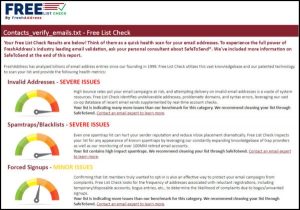A look back at this year’s trends in email marketing and what to look forward to next year.

It’s been a strange year for digital marketing. Between the switch to GA4 and the wider implementation of artificial intelligence (AI) tools, marketers have had to stay nimble in 2023! Nowhere is this more evident than in the mysterious, often confounding world of email marketing.
Litmus has brought back its “State of Email” report to help email marketers get the lay of the land after all this upheaval. Instead of one report at the end of the year, the team decided to split it up into four parts and release them periodically. Here is a recap of the first three releases below.
State of email workflows
Want to skip the recap and get right to the data? Download the entire State of Email Workflow Report!
How does an email go from an idea to generating a return? Litmus surveyed around 440 of our closest email friends to find out. Most respondents were marketing practitioners, often working at the intersection of design, development, content, and strategy. First, let’s start with workload.
How many emails must a marketer have in flow?
It’s rare for a marketing team to have just one email in production at a time. Of those interviewed, almost 30% work on around three to five emails at once. When you factor in personalization, you typically have two to three versions of each email. That means your email team may work on up to 15 emails simultaneously. That’s a lot of emails.
How are illustrious email marketers keeping up with the relentless pace of email workflows? Almost 40% of users said they work off a previous email, replacing the text and images. However, 42% of respondents would prefer to use a library of standard components. That’s a lot of email marketers using a method they would prefer not to be using!
Where’s the disconnect? With up to 15 unique emails in production simultaneously, it suddenly becomes clear why teams may be functioning in a way that they understand is sub-optimal.
What’s your priority?
Looking forward, what are email marketers most concerned with? The top three answers might look a little familiar:
- Expand personalization
- Implement more automations
- Improve deliverability
State of email design
Want to learn more? Download our full State of Email Design Report to get all of the facts.
The second part of the state of email report focuses on the email design process. It received 1,224 responses, the biggest turnout so far. As with the previous survey, the biggest chunk of respondents are responsible for a mix of email tasks, including design, development and strategy.
We design, therefore we are
The most common email design philosophy among email marketers was responsive, adaptive or hybrid design—hands down. This isn’t surprising since most industries have a pretty even split when it comes to contacts viewing emails on a mobile device or a desktop. It’s safest to design emails optimized for both.
Speaking of optimizing, what is top-of-mind for email designers? According to respondents, personalized and interactive content are the two primary focuses.
Dark mode and accessibility
Take it from us: Dark Mode and accessibility are two of the hottest topics in the email marketing realm.
That’s why it was surprising to learn that 33% of respondents weren’t coding specifically for Dark Mode. Even more surprising, 23% said they make all emails light, even in Dark Mode. Combined, that’s more than half of marketers surveyed ignoring Dark Mode.
On the bright side (pun intended), more email marketers are designing for accessibility. About half of respondents said they consider accessibility when it comes to font or text, design, and code. In total, only 17% of survey-takers said they don’t consider accessibility at all.
What’s in your toolbox?
When it comes to design, Adobe products secured the top three spots for most-used tools.
- Photoshop is used by 58% of respondents, taking the top spot by a large margin.
- Illustrator comes in a respectable second place with 37% of users.
- InDesign rounded out the top three with 31%.
The survey also asked where marketers are coding their emails.
- Adobe Dreamweaver was the top choice, with 29% of survey takers.
- Text Editor is used by 26% of the respondents.
- And finally, 25% of marketers said they use the code editor in their ESP.
Let’s get personal
Email personalization is no longer a nifty trend in the industry – it’s a tried-and-true method of increasing conversions and sending more relevant content. It’s absolutely necessary for the email marketer at this point.
From those surveyed, 62% of marketers use dynamic content to personalize their emails. Importantly, they’re seeing improvements from these most commonly used personalized elements:
- Sender name
- Subject line
- Copy
- Sending timing
Conversely, imagery, headers, footers and video content are the least personalized elements.
What data do marketers utilize to personalize?
- 68% of email marketers use name, company name, or other profile information.
- Customer segment (i.e., current customer or prospect) comes second with 54%.
- Past interactions take third place with 44%.
The topic of the hour – AI
Without a doubt, the topic du jour for marketers of all stripes is Artificial Intelligence (AI). For our second survey, respondents were asked whether they useg AI, and if so, how.
- 38.9% of those who responded said that they use AI.
- 17.57% said they use it primarily for brainstorming.
- Around half of the above group use ChatGPT.
- 25% of survey-takers said that they don’t currently use AI but plan to start.
- One-third of respondents stated they don’t use it and have no plans to do so.
State of ESP report
Want to learn more? Download the entire State of ESPs Report to get all of the facts.
For the third and most recent survey iteration, Litmus took a closer look at Email Service Providers (ESPs). On the best day, a good ESP runs in the background, providing reliable service and dependable data to our teams. On the worst days, your ESP may make you reconsider your chosen field of employment.
So let’s get into the good and the bad of ESPs.
This time, 758 total users contributed to the survey, representing all tenures and positions. In contrast to our previous surveys, the highest percentage of users were email strategists and operations managers.
Which ESP reigns supreme?
Looking for a new ESP? Wondering if the grass is greener with another provider? The top three picks of this year’s survey-takers are some familiar faces…
- Salesforce Marketing Cloud was the most-used ESP by a wide margin, with 27% of our sample size using it.
- MailChimp came in second with 19% of those surveyed.
- Hubspot followed behind with 13% of our sample size.
Salesforce also topped the list of satisfied customers:
- 69% of those using Salesforce reported being very or somewhat satisfied with the product.
- Hubspot has 61% of its users saying they are very or somewhat satisfied.
- Marketo snagged the third spot, with 56% of the sample size giving good marks.
Is the grass really greener on the other side? The jury remains out on that one!
Integration nation
Many marketers agree that a martech stack is only as good as its integrations. If you constantly have to transfer data from one system to another, especially manually, your mileage may vary…widely.
According to the data, the majority of users, 40%, classify their ESP as being adequately integrated with their other marketing channels. Only 30% report that their ESP is highly or very highly integrated.
Personalization and AI, part two
Personalization (and, by extension, AI) tops the list of all the features introduced in the past year.
When respondents were asked which features they regularly include in their emails, they said:
- 71% personalize the subject line
- 63.7% personalize using dynamic content
- 56% use animated GIFs or PNGs
Of those using personalization, the bulk of respondents said their ESP handles it very well or well. The same can be said about how our audiences’ ESPs handle AI-generated content. Around 72% of users said their ESP does well or very well with this type of content.
Let’s look forward
So what does all of this data tell us?
First, the email geek community is small but mighty! Marketers struggle with similar roadblocks, headaches and triumphs. Whether you’re part of a larger operation or you wear all of the hats, you’re not alone.
Secondly, personalization is here to stay, and it’s starting to look like AI might be too. If you’re not using these tools to improve your ROI, you may be missing out.
Finally, if you’re feeling overwhelmed, there are tools to help. Litmus is an all-in-one marketing platform that helps you get the most out of every send.
The post What’s the state of email beyond 2023? appeared first on MarTech.
(6)
Report Post








